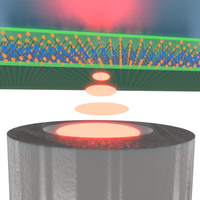Abstract
The introduction of an optical resonator can enable efficient and precise interaction between a photon and a solid-state emitter. It facilitates the study of strong light-matter interaction, polaritonic physics and presents a powerful interface for quantum communication and computing. A pivotal aspect in the progress of light-matter interaction with solid-state systems is the challenge of combining the requirements of cryogenic temperature and high mechanical stability against vibrations while maintaining sufficient degrees of freedom for in situ tunability. Here, we present a fiber-based open Fabry-Pérot cavity in a closed-cycle cryostat exhibiting ultrahigh mechanical stability while providing wide-range tunability in all three spatial directions. We characterize the setup and demonstrate the operation with the root-mean-square cavity-length fluctuation of less than 90 pm at temperature of 6.5 K and integration bandwidth of 100 kHz. Finally, we benchmark the cavity performance by demonstrating the strong-coupling formation of exciton polaritons in monolayer with a cooperativity of 1.6. This set of results manifests the open cavity in a closed-cycle cryostat as a versatile and powerful platform for low-temperature cavity QED experiments.
1 More- Received 9 March 2021
- Revised 6 August 2021
- Accepted 7 September 2021
DOI:https://doi.org/10.1103/PRXQuantum.2.040318
Published by the American Physical Society under the terms of the Creative Commons Attribution 4.0 International license. Further distribution of this work must maintain attribution to the author(s) and the published article's title, journal citation, and DOI.
Published by the American Physical Society
Physics Subject Headings (PhySH)
Popular Summary
The field of experimental quantum optics roots in our ability to control light, matter, and their interaction. For many solid-state systems, coherent light-matter coupling requires not only tight confinement of light in a cavity but also low-dephasing environments of reduced temperatures.
Our work presents an open Fabry-Pérot cavity platform as an optical resonator to control light-matter interactions in the cryogenic environment of a closed-cycle cryostat. The open cavity is formed by the concave end facet of an optical fiber mirror and a planar mirror which also serves as a support for solid-state samples. The combined system allows locating the region of interest on the solid-state sample as well as in situ tuning of the cavity degrees of freedom. Low temperatures are provided by a closed-cycle cryostat with much-reduced helium consumption but increased mechanical vibrations that challenge stable cavity operation. Our work demonstrates a solution to this technical challenge by a combination of passive and active vibration reduction strategies and techniques, achieving exceptional and robust mechanical stability and thus enabling the operation of high-finesse cavities in the cryogenic environment under closed-cycle conditions. Using this novel open cryocavity platform, we demonstrate the formation of exciton polaritons with two-dimensional semiconductors and cavity photons as a hallmark of strong light-matter coupling. Our results establish the concept of an open cavity in a closed-cycle cryostat as promising quantum hardware to advance the field of solid-state quantum optics and cavity quantum electrodynamics.



